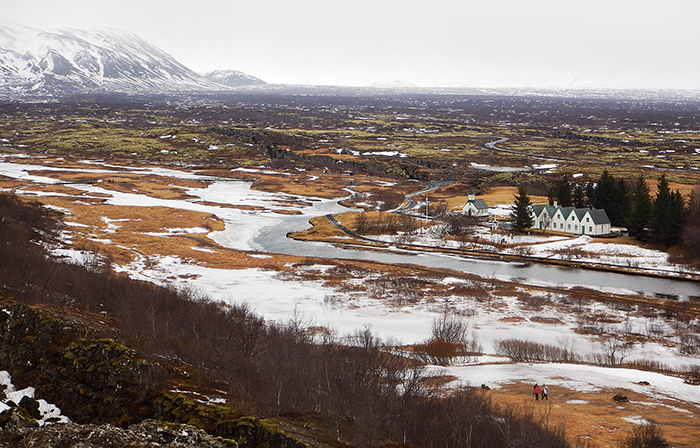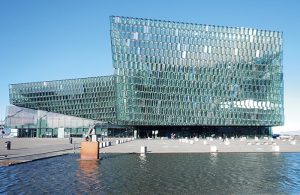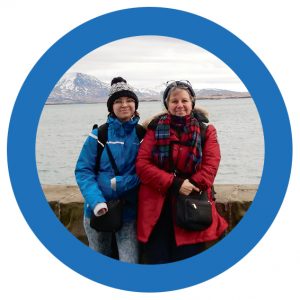 Most people want to escape somewhere warm during the cold months, but for one mother and daughter, Iceland was just too tempting
Most people want to escape somewhere warm during the cold months, but for one mother and daughter, Iceland was just too tempting
By Marie Verronneau and Ginette Michaud
Sólfar, the “sun voyager,” represents a Viking warship. Photos: Marie Verronneau.
We arrived at Iceland’s famous Blue Lagoon geothermic spa at eight in the morning, just a few hours after landing at Keflavik. Because the spa is located roughly halfway between the airport and Reykjavik, the capital, a knowledgeable source had recommended stopping there if we arrived at dawn—and so we did. It was a good tip: the spa will conveniently store your luggage for you—minus your swimsuit, of course.
The Blue Lagoon is, in fact, an artificial lake, created by the waters of the Svartsengi geothermal power plant. The spa’s waters are loaded with minerals, silicates, and micro-algae that give them a milky look—and also make them greatly beneficial for skin conditions such as psoriasis and eczema. You’ll even have the chance to make yourself a silica mud mask while lounging in the lagoon. On the other hand, your hair may become extremely dry if you let it soak too long, so it was recommended that we saturate our hair with conditioner—available from the shower distributors—to protect it.
The contrast between the surrounding snowbanks and the water’s heat—between 30˚C and 39˚C (86˚F–102˚F)—is truly amazing and gives the lagoon a misty appearance in the rays of the rising sun. The experience was very relaxing and helped rid us of the fatigue from a night spent on a plane.
On to Reykjavik
Feeling soothed and refreshed, we jumped onto the shuttle that took us from the Blue Lagoon to Reykjavik. The ride gave us the chance to take in the landscape of mountain ranges and lava fields.
For those who love to hike, Iceland is certainly a paradise. We prefer to do our touring by bus, but many other options are available, including minibuses, Jeeps, snowmobiles, boats, horseback riding, and rafting.
A relatively young island in geologic terms, Iceland is located directly on the Mid-Atlantic Ridge, which separates the Eurasian tectonic plate from the North American plate. The country is, in fact, “the only inhabited island in the world where tectonic plates and the ocean ridge are visible on land,” according to the travel website funiceland.is. The movement of the two plates against each other is responsible for the intense volcanic activity that created the island nation. Volcanoes are still very active, as was demonstrated by the eruption of Eyjafjallajökull in 2010, which disrupted European air traffic for more than a week.
Travelling from the south of the island towards the capital, we saw the snow disappearing gradually. At Reykjavik—which means “bay of smokes”—the temperature was much milder. The island’s geothermal energy is actually used to heat the sidewalks.
After we left the shuttle, we dropped off our luggage in the lobby of the Apartment K hotel, which offers fully equipped, stylish suites and studios. Located in the area called 101 Reykjavik, the hippest part of Iceland, our accommodations put us within walking distance of most of the capital’s cultural activities.
Out for a walk on a bright sunny afternoon, we were drawn to the sea we had only glimpsed from the bus. Our first stop was Sólfar—the “sun voyager”—a replica of a Viking warship created by Jón Gunnar Árnason in 1990 to commemorate the 200th anniversary of the city of Reykjavik. Made of stainless steel and seated on a granite disk that reflects both the sculpture and the sky, it’s ideally placed on a promenade along the waterfront and facing the impressive Mount Esja across an expanse of water.
We followed the promenade up to Harpa, a concert hall and conference centre. An imposing building composed of a steel frame covered with glass panels of various sizes and colours, it quickly became an important landmark in the capital after it opened in 2011; the concert hall is renowned for its acoustic qualities.
Moving on, we spotted a heroic-looking statue dominating a small hill—a tribute to Ingólfur Arnarson, a Norse chieftain. He and his wife and brother are considered the first settlers of Iceland and the founders of Reykjavik, arriving—according to folklore—in 874.
Iceland is a small island with a big story. The Vikings settled there with their Irish slaves in the late 9th century. In 930, the clan leaders decided to create the world’s first parliament, the Althing, on a site called Thingvellir about 45 kilometres (28 miles) east of the capital. (The parliament was moved to Reykjavik in 1844.)
Norway took control of Iceland in 1262, and later, when the kingdoms of Norway, Denmark, and Sweden joined in the Kalmar Union in 1397, it came under the union’s jurisdiction. Christianity was declared the official religion of the country around the year 1000, and Lutheranism was imposed in the mid-16th century. It wasn’t until 1944 that Iceland finally became an independent republic.
Eventually we came to the capital’s main street, Laugavegur, which means “wash road.” The oldest commercial street, it’s filled with all kinds of boutiques, bars, and restaurants and is a must-see during any visit to Reykjavik.
After a full first day, we lazily returned to the hotel for a homemade supper and a well-deserved night’s sleep.
Whales and Art
The next morning, we quickly realized that the day would be a cloudy one, as is common in this northern country. But bad weather never discourages us, so we simply carried on with our urban exploration.
We passed through the old harbour, with its colourful houses and fishing boats, heading for the Whales of Iceland exhibition, an interactive installation that displays life-sized models of the 23 species of whale found in Icelandic waters, including the blue whale, sperm whale, and right whale. The hand-painted models are soft and can be explored by both little hands and big hands.
We wandered among the whales, surrounded by whale sounds, while the audio guide supplied us with information. We were particularly impressed with the narwhal, with the unique twisted tusk that inspired the myth of the unicorn, and with the awe-inspiring size of the sperm whale that reminded us of the famous Moby Dick. Our favourite was the friendly humpback. We really enjoyed the visit.
After lunch, we headed to the little lake called Tjörnin—more of a pond, in fact—on which a quantity of birds including swans and mallard ducks swam peacefully. People are so fond of feeding the birds that the lake earned the nickname “the biggest bread soup in the world.”
The National Gallery of Iceland was our next stop. The gallery contains an extensive display of Icelandic art, from traditional to contemporary paintings, drawings, and installations. One of the things you can’t help noticing in Reykjavik is the omnipresence of public art. Graffiti, large murals, and sculptures are everywhere on the streets and sidewalks and in parks.
We were looking forward to an evening we had planned—a bus tour to see the Northern Lights—but because of the cloudy sky, the expedition had been postponed to the following evening.

The church and the farm of Thingvellir.
Geysers and Waterfalls
Our third day began like our second—under a cloudy sky. We had booked a tour of the Golden Circle, an excursion that takes in an important historic and geologic site, a geothermal phenomenon, and some famous waterfalls.
The first stop was Thingvellir National Park, located where the North American and Eurasian tectonic plates are slowly pulling away from each other. The park was founded in 1930 to mark the thousand-year anniversary of the Althing, the legislature of Iceland. Lögberg, or “law rock,” is a reminder that this is where the outdoor parliament was held, where the leaders debated during the summer solstice under the midnight sun, rain or shine—for two weeks! In 2004, the park became a UNESCO World Heritage Site.
From a height, we contemplated the large rift, the little church, and the farm of Thingvellir, as well as Thingvallavatn, Iceland’s largest natural lake. The site conveyed both a particular solemnity and breathtaking beauty. It has served as a location for some episodes of the popular TV series Game of Thrones. If you’re intrepid enough, you can snorkel inside the Silfra fissure.
Our second stop was the geothermal area of Geysir, a field of hot springs and the source of the word geyser. Now mostly dormant, Geysir erupts only once every few years, whereas the Strokkur ejects its column of boiling water every five to 10 minutes, much to the delight of visitors.
Because this stop was the longest of the day, we were advised to get some lunch at the cafeteria on the site. It gave us the chance to try Kjötsúpa, the traditional Icelandic soup made with lamb or mutton.
Our last stop was the Gullfoss falls. Before us, a large and impressive waterfall cascaded in three steps in a canyon created at the end of the Ice Age. The cataract’s noise reminds you how powerful and magnificent nature is.
During the long bus ride, our guide entertained us with plenty of information, stories, and legends that helped us understand the inhabitants of this Nordic country. We learned about the huldufólk, or “hidden people,” elflike creatures who still occupy an important place in Icelandic life.
Even though we greatly appreciated the six-hour tour, we felt a bit rushed at each stop and couldn’t appreciate the landscape as much as we would have liked. If you go, consider the eight-hour tour, which includes an extra stop at a geothermic greenhouse.
That night for our dinner out, we chose SmakkBarinn, a restaurant that serves not Spanish but Icelandic-style tapas. It was a great place that pleased both carnivorous mother and vegetarian daughter. Every selection was served in a common jar and presented on a wooden plate, all in the tropical décor of the adjacent Bar Ananas. It really was an unusual experience.
Sadly, our second attempt to see the Northern Lights was cancelled.
The Northern Lights at Last—Sort of
March 15 marks the beginning of Design March, a celebration of Icelandic arts from fashion to architecture, so we began the next day with a visit to Hafnarhus, an important art installation—part of the Reykjavik Art Museum—showing the work of, among other renowned artists, Erró, whose mural had welcomed us at the airport. The art displayed was mostly contemporary.
Our first stop that afternoon was the unique landmark, Hallgrimskirkja church, consecrated in 1986 in memory of the poet and clergyman Hallgrímur Pétursson. Its impressive rocket-shaped tower contrasts with the Lutheran sobriety of its nave. Soaring 74.5 metres (244 feet) into the air, the tower has an observation deck, but it was raining and we decided to postpone our ascent of the tower, hoping for a clearer sky.
After the church, we visited Kjarvalsstaðir, also a part of the Reykjavik Art Museum, which displays a great collection of drawings by a local artist, Sigga Björg Sigurðardóttir. Her art, filled with strange creatures—half-animal, half-human—and almost solely in black and white with occasional touches of colour, carried us off to the world of Icelandic myth.
By the end of the afternoon, we were able to access the elevator that took us to the top of the Hallgrimskirkja tower. There we were able to contemplate the city in all its glory, with its myriad colourful houses, the lake, and the snowy mountains. We were overwhelmed by the vista and its magnificence.
In front of the church sits a statue of Leif Erikson, born in Iceland around 970 and the son of the infamous Erik the Red. We felt a special connection with him, since in 2016 we had visited the archaeological site of Vinland, the Viking settlement at L’Anse aux Meadows in the northern peninsula of Newfoundland.

Harpa.
For yet another night, we were told that we wouldn’t be able to see the Northern Lights, so we settled for the Aurora Reykjavik exhibition. The exhibit not only recreates different types of Northern Lights, but also explains the facts and myths about them over the centuries. You can also learn how to capture them with your camera. And best of all, we got to watch a high-definition film featuring the most wonderful Northern Lights in the best spots of Iceland.
The next morning, we dedicated our remaining time to admiring the mountains one last time before departing. The thought of leaving this beautiful, calm country saddened us, but we were already planning our next visit, when we would add the West Fjords, a volcano, and a glacier to our itinerary. And perhaps a concert at Harpa.



 Most people want to escape somewhere warm during the cold months, but for one mother and daughter, Iceland was just too tempting
Most people want to escape somewhere warm during the cold months, but for one mother and daughter, Iceland was just too tempting 